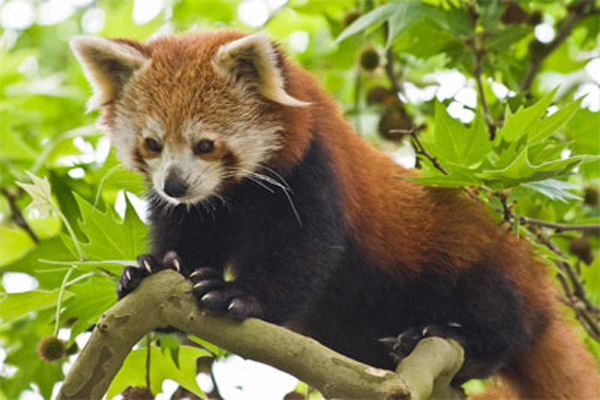RED PANDA
Ailurus fulgens (or ochraceus); Phasis wallengrenii
Physical Description
The Red Panda is also known as the Lesser Panda, the Common Panda, the Bright Panda, the Red Cat Bear, and the Fire Fox. Though the Giant Panda is the Red Panda’s closest relative, the Red Panda actually looks more like a raccoon.
The Red Panda’s fur is thick and russet-coloured, and its black-tipped tail has nine white and yellow bands. The Panda has a bear-like body, short legs, and a specialised wrist bone called the radial sesamoid that the Panda uses for grasping bamboo stalks. Unlike other bear species, the Red Panda’s claws are partly retractable. The Red Panda is only slightly bigger than a large housecat, its body weighing 3 to 6 kilograms (7 to 13 pounds) and measuring between 55 and 65 centimetres (22 to 26 inches) in length. The Panda’s tail measures between 40 to 45 centimetres (16 to 18 inches) long.
Habitat
The Red Panda inhabits mountainous temperate forests with a bamboo understory, at elevations from 1,500 to 4,000 metres (5,000 to 13,000 ft). The Panda occurs within the moderate climate zones of southern and southeastern Tibet, particularly in the counties of Dechen, Gyalthang, and Balung in Dechen Prefecture. The Red Panda also occurs in the dense lowland forests of northeastern Tibet. A few Red pandas reside outside of Tibet, in the Himalayan regions of Nepal, Sikkim, Bhutan, Burma (Myanmar), Laos, and western China.
Eating Habits
The Red Panda, like the Giant Panda, was originally a carnivore. Today, the Panda’s diet is mostly vegetarian. The Red Panda predominately eats bamboo leaves, but may supplement its diet with bamboo shoots, acorns, berries, mushrooms, grasses, roots, lichens, and bark, especially in the spring and summer. The Panda spends much of its day feeding and has developed a low metabolism in order to compensate for the discrepancy between its low-calorie diet and the meat-based diet its digestive system is adapted for. Furthermore, the Red Panda does consume a small amount of meat from time to time – usually insects, but sometimes also bird eggs, nesting birds, and the occasional mouse or bamboo rat.
Behaviour and Reproduction
The secretive and gentle Red Panda sleeps through most of the day, curled up with its tail wrapped around its head. The Panda is most active at dusk and dawn. An agile climber, the Red Panda spends much of its time in the trees. The Panda moves slowly on the ground.
The Red Panda is a solitary animal, except for mothers with cubs. The home ranges of males may overlap those of several females. Mating occurs in early winter. Males attract females to them with loud cries. During the gestation period, which lasts 112 to 158 days, Red Panda females build dens in which to give birth. Maternal dens are constructed in cavities such as tree hollows and rock crevices. Births occur in spring and summer, with most cubs born in June.
Each Red Panda mother gives birth to one to four, but usually to two cubs, per breeding season. Cubs weigh about 100 grams (3.5 ounces) and measure about six centimetres (2.4 inches) in length at birth. Newborn cubs are completely covered in shiny white fur. The cubs’ fur begins to darken to the russet colour of the adults’ fur a week or so after birth. Cubs open their eyes about 20 days after birth. Cubs generally remain with their mothers for the first year of their lives. Red pandas reach full size at 12 months and sexual maturity at about 18 months. The Red Panda’s life span is 12 to 14 years.
Present Status
The Red Panda is categorized as Endangered in the 2003 IUCN Red List of Threatened Species and is listed under Appendix I of CITES. The Red Panda is under second class protection in China and is included in Schedule I, Part I of the Indian Wild Life (Protection) Act of 1972. In 1999, the IUCN estimated the number of mature Red pandas left in the world to be around 2,500. The Red Panda’s population is declining.
Threats to Survival
Habitat loss is the main threat to the Red Panda’s survival. Large areas of the Panda’s forest habitat have been cleared for agriculture. Trees in the forest have also been cut down to provide timber and firewood for the needs of China’s growing population. A survey revealed that the Red Panda population density has been significantly reduced in areas of their habitat that have been degraded by commercial logging. The Red Panda is also poached for its fur and the pet trade. The Red Panda’s small population has a relatively low reproductive rate, making the threats habitat loss and poaching pose to the species’ survival even more severe.
References
BBC, Science & Nature – Wildfacts – Red panda, Lesser panda, http://www.bbc.co.uk/nature/wildfacts/factfiles/6.shtml, Aug 2004.
Heath, T. and J. Platnick, 1999: Ailurus fulgens, Animal Diversity Web, http://animaldiversity.ummz.umich.edu/site/accounts/information/
Ailurus_fulgens.html, Aug 2004.
Ireton, Rob, Red Panda House, Red Panda (Ailurus fulgens), http://home.fuse.net/redpanda/redpanda.html (2003).
Laidler, Liz and Keith, 1996: China’s Threatened Wildlife, London.
Massicot, Paul, Animal Info – Red Panda, http://www.animalinfo.org/species/carnivor/ailufulg.htm, July 2004.
Mustelid Specialist Group, 1996: Ailurus fulgens. In: IUCN, 2003: 2003 IUCN Red List of Threatened Species, http://www.redlist.org, Aug
2004.
PBS, The Living Edens: Bhutan – Animal Archive – Red Panda, http://www.pbs.org/edens/bhutan/a_rp.htm, Aug 2004.
By: Environment and Development Desk, DIIR, CTA.



comment 0